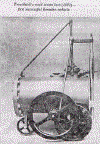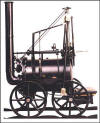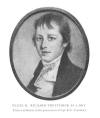|
|
||
|
WHO INVENTED STEAM
LOCOMOTIVE ? RICHARD TREVITHICK (1771-1833). A Cornish Mine Manager's son. He earlier in 1801 invented the road-locomotive, putting upon the highways on Christmas Eve 1801, the first steam propelled vehicle for passengers. This invention was not for the railway but for the highway. |
||
|
Richard
Trevithick, was born in Illogan, Cornwall, in 1771.In 1796
Trevithick began experimenting with the idea of producing a steam
locomotive, and produced one . The boiler and engine were in one piece; hot
water was put into the boiler and a red-hot iron was inserted into a tube
underneath; thus causing steam to be raised and the engine set in motion. In
1801 he produced another bigger locomotive named the ' Puffing Devil' ,
which consisted of a cylindrical horizontal boiler and a
single horizontal cylinder let into it. The piston, propelled back and forth
in the cylinder by pressure of steam, was linked by piston rod and
connecting rod to a crankshaft bearing a large flywheel, it
could only go on short journeys as he was unable to find a way of keeping up
the steam for any length of time. |
||
|
Stephenson
on
September 27, 1825,
won
his first great triumph by
putting a locomotive on the line that was able to draw 38
wagons ( not coaches), laden with goods and 600 passengers at a rate of 12 miles
an hour, with Stephenson at the controls, thus
inaugurating the first public
steam railway of the world. It is interesting to note that the 600
passengers were made to ride on wagons. |
||
|
George and Robert Stephenson with family |
||
|
|
||
|
THE RAINHILL TRIAL
After
this incident George
Stephenson's fame as a railway engineer sky-rocketed and he was very much in
demand all over the world as a consultant and engineer. Subsequently in 1929 ,
George assisted by his son Robert, was engaged in construction of the Liverpool
and Manchester railway line,
which was meant for hauling wagons by a cable , wound by stationary steam
engine. Stephenson tried his best to convince the company to use steam
locomotives . But at last the company consented to conduct a "
trial" at Rainhill and
on 25th. of April 1929 an advertisement appeared to offer a prize money of
500 pounds sterling over and above the cost of the engine for the most improved
locomotive during a trial.. It would be interesting to know the "
terms and conditions " of the trial. 2. The maximum engine weight was stipulated as 6 tons. 3. The engine should be able to haul a trailing load of 20 tons at 10 miles per hour on level section. with boiled pressure of 20lbs. per Sq. inch 4. The basic price of the engine should not exceed 550 sterling pounds.
It is
also interesting to note that since this trial was to be conducted on a level
section and since the longest perfectly level section was only 1.5 miles
at Rainhill, each contestant was required to travel backward and forward ten
times , making a total journey of 30 miles. |
||
|
Locomotion No. 1 |
The Liverpool
- Manchester line was completed and a colourful inauguration
ceremony was organised on 15th. September 1830. It is unfortunate
that this inauguration ceremony was marred by a tragedy. when one of the
invited V.I.Ps William Huskisam M.P. and a former cabinet minister was
fatally run over by " The Rocket". Obviously the train did not
have effective brakes.
This can be termed as the first
train accident in the history of Railways. |
|
|
PREJUDICE AND OPPOSITION People every where in the world have been prejudiced to oppose any new invention. In case of railways also there was enormous prejudice, opposition and criticism. 1. Queen Victoria after 17 years of opening of the first railway in the world, was advised by her council of ministers that it was "safe" for Her Majesty to take a trip from London to Slough on 13th. June 1842. But "The Atlas" , a popular paper expressed concern over the "fearful tremendous evil " excursion of the Queen and prayed either it should be wholly abandoned or only occasionally resorted to". 2. In 1835 John Bull denounced the railways as a menace. 3. In India many people at the beginning also opposed stating " hazardous and dangerous venture." Many British in India considered " premature and expensive undertaking". They feared even if it could be started it will not be able to attract people from Bullock Carts and the people were so poor that they cannot be persuaded to spend money on railway travel. The great Indian economist Romesh Chandra Dutt considered railways as wasteful expenditure and at best deserve the secondary priority to roads and canals. Even Lord Lawrence the Governor-General considered "water ways will be more important for the country than railways. 4. I'm astonished when we see in the recent past during the introduction of Metro Railways in Calcutta , a renowned politician advised people not to board the Metro because there is every possibility of the tunnel breaking over our head. BUT STILL THE RAILWAYS HAVE OVERCOME ALL OPPOSITION AND MARCHING FORWARD WITH SPEED AND SUCCESS.
|
||
|
The author of
the page acknowledges help from old Eastern Railway Magazines IR magazines and
from steam loco web pages and a lot many books and articles on the
subject. Interested to read more such stories and know more on this subject
steam engines? Must visit |
||
|
Please post your comments mreenaldas@yahoo.co.in |
THANK YOU FOR VISITING THIS PAGE |
|











